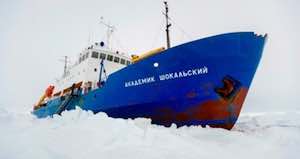
It should be clear to global warming polar researchers that sea ice at the South Pole is not melting, but in fact has been growing for 37 years, reports Pierre Gosselin. (1)
Yet, recently another ship got caught in the Antarctic ice. The Antarctic 'Aurora Australis' with 68 people on board became stranded in sea ice in the West Arm in Horsehoe Harbor the last week in February, and rescue efforts were prevented by a snowstorm. They were eventually rescued. The problem: Too much ice!
The Aurora Australis may ring a bell. This is because it is the ice breaker that ultimately helped rescue the 52 person crew on board the sea ice trapped research vessel Akademik Shokalskiy which ferried a global warming/polar ice melt exploration led by Prof. Chris Turney back in early 2014. That expedition devolved into a highly publicized folly attracting much worldwide ridicule. Eventually, a helicopter from the Chinese ice breaker Xue Long succeeded ferrying Turney and his crew to safety. (1)
Joannne Nova reported that early-on the Chris Turney expedition was described as a mission to answer questions about climate change. Then it became a Russian ship stuck in sea ice in Antarctica. (2)
She adds: “Let there be no doubt, the mission was to document and record scientific changes in Antarctica and to broadcast that to the world. Most scientific missions don't have a dedicated media team, but this one manned a staff of five journalists. If they'd discovered less sea ice, fewer penguins, or big cracks, we know the images would be all over the mass media and it would be evidence for 'climate change.' But with the MV Akademik Shokalskiy trapped by thick sea ice, the mission apparently was to call it a tourist boat. (2)
Some notes on the Antarctic:
In the case of Antarctica, the climate models have been dead wrong. Chinese scientists found that most climate models predicted Antarctic sea ice coverage would shrink as the world warmed and greenhouse gas levels increased. The opposite happened. (3)
The sea ice extent around Antarctica has been expanding in recent years. In fact, both in 2013 and 2014 it increased repeatedly to new all-time record levels. (4) And the trend continues.
In addition, the sea ice surrounding Antarctica may be thicker than previously thought. Earlier estimates using shipboard observations and drill cores suggested that the Southern Ocean ice pack was about 1 meter on average. New measurements show ice floes with average thicknesses ranging from 1.4 to 5.5 meters, with some areas as thick as 16 meters. Researchers reported they have a fairly good sense that this ice may represent a significant portion of the pack. (5)
Thicker ice is less prone to melting. So the recent measurements could help explain why the ice pack has expanded since 1979 despite rising water and air temperatures.
Lastly, University of Pennsylvania researchers report that deposits in an ancient lake in Antarctica have remained frozen for at least the last 14 million years, suggesting that the surrounding region, the East Antarctic Ice Sheet (EAIS) has likewise remained intact. (6)
The work adds new support for the idea that the EAIS did not experience significant melting even during the Pliocene, a period for 3 to 5 million years ago, when carbon dioxide concentrations rivaled what they are today.
“The Pliocene is sometimes thought to be an analog to what Earth will be like if global warming continues,”said Jane K. Willenbring, an assistant professor in Penn's School of Arts & Science. “This gives us some hope that the EAIS could be stable in today's and future climate conditions.”
By offering support for the idea that the EAIS has been largely stable during the last 14 million years, the research offers some hope that a massive collapse of the ice sheet, and associated sea level rise of tens of meters, may not be imminent.
So, unlike the rest of the planet, the Antarctic interior has not warmed over the last few decades and has even shown signs of slight cooling. (7) Ship expeditions in the take note!
References
1. Pierre Gosselin, “Ice breaker which helped rescue Turney's 'ship of fools' gets jammed in meters- thick summertime Antarctic sea ice,” notrickszone.com, February 29, 2016
2. Joanne Nova, “Third icebreaker abandons rescue of climate scientists boat in Antarctica, media fog obscure, don't say 'climate'”, joannenova, December 30, 2013
3. Michael Bastasch, “Antarctic sea ice did the exact opposite of what models predicted,” dailycaller.com, March 2, 2013
4. Klaus L. E. Kaiser, “Antarctic sea ice in not disappearing but increasing,” Canada Free Press, November 12, 2014
5. Thomas Sumner, “Antarctic sea ice plot thickens,” Science News, December 27, 2014, Page 10
6. Katherine Unger Baillie, “East Antarctic ice sheet has stayed frozen for 14 million years, Penn team reports,” upennnews/news, December 15, 2015
7. Thomas Sumner, “Warming culprit carbon dioxide has a cool side,” Science News, January 9, 2016, Page 10
 It should be clear to global warming polar researchers that sea ice at the South Pole is not melting, but in fact has been growing for 37 years, reports Pierre Gosselin. (1)
Yet, recently another ship got caught in the Antarctic ice. The Antarctic 'Aurora Australis' with 68 people on board became stranded in sea ice in the West Arm in Horsehoe Harbor the last week in February, and rescue efforts were prevented by a snowstorm. They were eventually rescued. The problem: Too much ice!
It should be clear to global warming polar researchers that sea ice at the South Pole is not melting, but in fact has been growing for 37 years, reports Pierre Gosselin. (1)
Yet, recently another ship got caught in the Antarctic ice. The Antarctic 'Aurora Australis' with 68 people on board became stranded in sea ice in the West Arm in Horsehoe Harbor the last week in February, and rescue efforts were prevented by a snowstorm. They were eventually rescued. The problem: Too much ice!